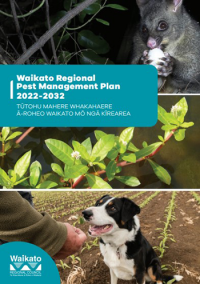2022-2032 Regional Pest Management Plan | Tūtohu Mahere Whakahaere Ā-Roheo Waikato Mō Ngā Kīrearea
 How we minimise the impacts of pests in our region.
How we minimise the impacts of pests in our region.
Waikato Regional Council has regional leadership for pest management in the Waikato region. The council’s Biosecurity Strategy defines what that leadership looks like and outlines our regional biosecurity priorities. The Waikato Regional Pest Management Plan 2022-2032 is the statutory biosecurity document that sets out the rules occupiers in our region must comply with, so we can all work to protect the things we value in our region.
What is the RPMP?
Regional pest management plans (RPMP) are prepared by regional councils under the Biosecurity Act. They are regulatory plans, particular to a region, that identify harmful organisms considered to be pests in that region, with their management governed by rules.
Following extensive engagement and consultation, the Waikato Regional Pest Management Plan 2022-2032 became operative on 4 July 2022.
The RPMP states the management programmes and rules for pest plants and animals in the Waikato region.
What the RPMP aims to achieve
- Build on past biosecurity gains, like those achieved through council’s direct control and in Priority Possum Control Areas.
- Focus resources on excluding, eradicating or containing high threat/low incidence pests to make the greatest difference.
- Support work being undertaken, especially in high value areas and specific sites, e.g. wetland site-led areas, and tussocklands of the Central North Island through Project Yellow.
- Reduce the impacts of pests on neighbours, to support the work they are doing on their properties.
- Reduce the risk of land development and subdivision activities from spreading pests.
- Help ensure transport corridors and quarries do not harbour and spread pests.
- Complement and align with pest management programmes in neighbouring regions.
Duration
According to section 77(5) of the Biosecurity Act, the RPMP takes effect on the date it becomes operative and remains in force for 10 years from that date: 4 July 2022 to 5 July 2032.
It may cease at an earlier date if the council declares by public notice that the plan has achieved its purpose, or if following a review, it is revoked.
Exemptions
Section 78 of the Biosecurity Act 1993 allows Waikato Regional Council to issue exemptions to aspects of the RPMP, under certain conditions, including that the exemption must not significantly prejudice attainment of the plan’s objectives.
A summary of existing exemptions is recorded in the Exemptions Register. To view the Exemptions Register, or to apply for an exemption, contact the biosecurity team at RPMP@waikatoregion.govt.nz.
Read the plan
You can read the RPMP below, either as a full document or in sections.
WAIKATO REGIONAL PEST MANAGEMENT PLAN 2022-2032 | TŪTOHU MAHERE WHAKAHAERE Ā-ROHEO WAIKATO MŌ NGĀ KĪREAREA (full document)
PART 1: PLAN ESTABLISHMENT | TE WHAKAKAUPAPA I TE MAHERE
Introduction | Kupu whakataki
Planning and statutory background | Te mahere me te horopaki ā-ture
Responsibilities and obligations | Whakataunga mahi me ōna whakaaetanga
GLOSSARY | RĀRANGI WHAKAMĀRAMA
APPENDICES | NGĀ APITIHANGA
Appendix 1 - Alphabetical list of pests and management categories
Appendix 2 - Modified McLean Scale
Appendix 3 – Dama Wallaby Progressive Containment Map

